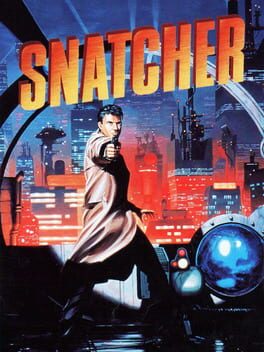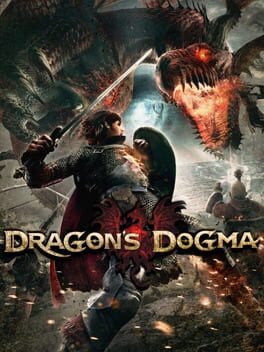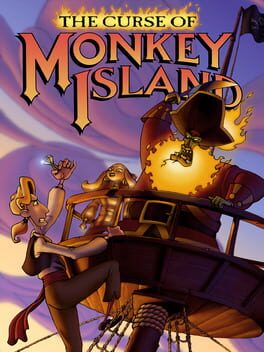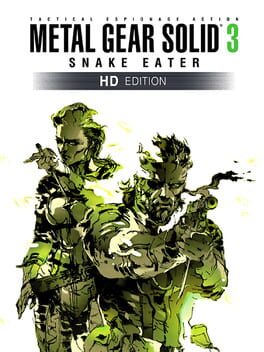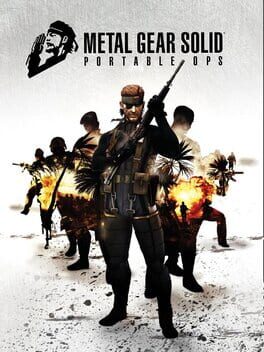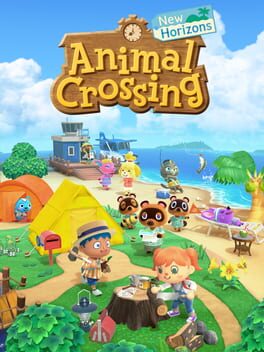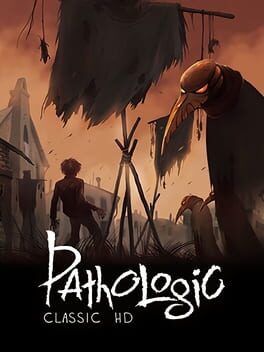nex3
BACKER
1992
Although the plot is shaky at times (particularly in the third act) and the combat is rough without a light gun, this still feels like a pristine video game. The art is still gorgeous thirty years later, moody pixel art cityscapes perfectly rendering the first wholeheartedly cyberpunk video game and providing a visual legacy for the twilight of the original cyperpunk era. Even the pacing is excellent, which is quite a trick to pull off for an adventure game—a genre I dread as much as I love simply for how much time I end up spending reading item descriptions. It's a blessing that this got a contemporary release in the west.
1989
This is pretty fascinating as a design object. It's so parsimonious with its mechanics, it feels like something you'd see as an itch.io microgame today—probably with a slightly more graceful UI, but still. The logic of how your followers behave is so clearly laid out by the manual and so intimately tied to the strategy of your game that this feels as much like shepherding a cellular automaton as it does like being a patron deity.
It's a little too minimal to be all that much fun or particularly compelling to play more than a couple times. It lacks the campaign mode that give later real-time strategy games their long legs, but for a game from 89 it's a pretty impressive precursor.
It's a little too minimal to be all that much fun or particularly compelling to play more than a couple times. It lacks the campaign mode that give later real-time strategy games their long legs, but for a game from 89 it's a pretty impressive precursor.
1999
It's impossible not to compare this to Resident Evil. This game shines on a narrative level: the plot is more robust and interesting and the environment design leans substantially less heavily on existing horror tropes and ends up legitimately unsettling as a result. The mechanics, on the other hand, are much less revelatory and end up decidedly obnoxious in boss fights that turn the tank controls from an artistic decision to a pure impediment.
The biggest innovation relative to the survival horror progenitor is the wide open city overworld shrouded in the series's iconic fog. This turns the whole dynamic of the game's resource management on its head. No longer do foes exist exclusively on a room-by-room basis, where figuring out how to successfully route around an enemy is as valid a solution as killing it. Silent Hill presents a version of the dungeon crawler's core question: will you take the risk of exploration in exchange for the rewards you may find?
Broadly speaking, if you're decent at the game, killing the foes you encounter in the overworld so you can explore it thoroughly will give you more resources than you spend. On the other hand, if you (like me) try to play this like Resident Evil and conserve your healing items and ammunition by carefully avoiding combat while making your way directly to your next objective, you'll miss not just useful items but a deeper understanding of the plot and indeed the possibility of a good ending.
Silent Hill thus ends up being a very different kind of survival horror. You're certainly still hoarding resources, but you're not running scared in the same way. The game throws frightening beasts at you but it also asks that you learn to face down and overcome them. In doing so, it dilutes the fear somewhat, and I think that's a bit of a shame.
The biggest innovation relative to the survival horror progenitor is the wide open city overworld shrouded in the series's iconic fog. This turns the whole dynamic of the game's resource management on its head. No longer do foes exist exclusively on a room-by-room basis, where figuring out how to successfully route around an enemy is as valid a solution as killing it. Silent Hill presents a version of the dungeon crawler's core question: will you take the risk of exploration in exchange for the rewards you may find?
Broadly speaking, if you're decent at the game, killing the foes you encounter in the overworld so you can explore it thoroughly will give you more resources than you spend. On the other hand, if you (like me) try to play this like Resident Evil and conserve your healing items and ammunition by carefully avoiding combat while making your way directly to your next objective, you'll miss not just useful items but a deeper understanding of the plot and indeed the possibility of a good ending.
Silent Hill thus ends up being a very different kind of survival horror. You're certainly still hoarding resources, but you're not running scared in the same way. The game throws frightening beasts at you but it also asks that you learn to face down and overcome them. In doing so, it dilutes the fear somewhat, and I think that's a bit of a shame.
2023
The core mechanic here looks incredible at first, and the first few times you play with it—as well as several of the elaborations that appear throughout the game—are stunning. But the rest of the game just can't bear its weight. The puzzles themselves are fine if by-the-book elaborations on the core conceit, but it quickly becomes clear that the designers struggled to find as much depth as they hoped in it. Perhaps the mechanic is just too complex on its face and as such too difficult to extend into a full game's length.
While you play, you are weighed down by the game's dull writing and ceaseless blandly-positive commentary from the virtual cat that follows you around. If you do take the time to pay attention to the plot, you'll quickly find that it makes no sense: a group of climate researchers created a virtual environment, but they constantly marvel at the "physics-defying wonders" they create within it, as though physics within a simulation of your own design is anything more than you say it is. The player is "caught" in the virtual reality despite an early scene clearly showing them in more of a VR booth than jacked into a headset. It's boring, it's sloppy, and it would be an unambiguously better game if it just presented a series of puzzles without any commentary.
While you play, you are weighed down by the game's dull writing and ceaseless blandly-positive commentary from the virtual cat that follows you around. If you do take the time to pay attention to the plot, you'll quickly find that it makes no sense: a group of climate researchers created a virtual environment, but they constantly marvel at the "physics-defying wonders" they create within it, as though physics within a simulation of your own design is anything more than you say it is. The player is "caught" in the virtual reality despite an early scene clearly showing them in more of a VR booth than jacked into a headset. It's boring, it's sloppy, and it would be an unambiguously better game if it just presented a series of puzzles without any commentary.
2024
Coming to this from 13 Sentinels it is almost precisely the opposite of what I expected. Where 13S has a phenomenal plot full of complexity, mystery, and deep characterization, UO's written like generic pulp fantasy—no, not even that, like a monster-of-the-week TV show apisiring to generic pulp fantasy. But where 13S's combat feels sloggy and bolted-on, UO's is consistently fun and reasonably engaging.
The core failing of the game is the fact that word, "reasonably". Although battles in the game are never boring, the systems promise far more than they're actually able to deliver. The game is stuck between two worlds: a stolid traditional Attack Magic Item Flee system and an FFXII-style fully automated luxury battlesim. It's straining towards the latter and it almost manages to grasp it, but the small gap remaining makes all the difference.
The goal of a system like this is to elicit in the player strategic thinking. Consider which characters complement one another's skills, which skills are useful in which circumstances, how to make a unit that's flexible, powerful, and effective against the present challenge. Find clever combinations of skills and equipment that exploit holes in your enemies' defenses. This is what Unicorn Overlord wants, and it's what it narrowly misses.
This is how a battle goes: your unit (composed of several characters) bumps into an enemy unit. Each unit is arranged on its own 3x2 grid, and each character has a set of active and passive actions they use under certain user-defined conditions in initiative order as long as they have resources. You can customize these before the battle, swap equipment with anything in storage, and the game will tell you how much net damage you will deal and how much you will take. Once you're satisfied with your setup, you hit go and the battle plays out automatically. Since resources are very limited, most battles only last a few "turn cycles" as they would exist in a Dragon Quest style system.
In practice, this system has a few critical issues. The first and most noticeable is the degree of variance in each battle. Whether hits are critical or miss entirely is up to the random number generator, which is of course quite sensitive to initial conditions—as indeed are the deterministic behaviors of a battle. This means that you can change a prospective battle from losing to winning often enough by simply rearranging your characters or toggling skills on and off arbitrarily, a practice which quickly overwhelms the amount of time you spend on actual tactical decisions.
The ability to change a unit's programming for each battle also erodes the gap between this system and something more traditional. With some finagling, you can usually choose fairly specifically which enemy will be hit by which attack, allowing you to essentially route around the automation and pre-plan a more standard RPG battle. That level of customizability undermines the conceit of programming.
At the furthest extreme, because you can swap any equipment with anything in storage before a battle or between battles, in principle the best way to play is to keep all your top-tier gear unequipped and just swap it on each unit before they fight and off once they're done. I couldn't bring myself to go to such noxious lengths most of the time, but I did keep a few "just in case" initiative boosters around.
I hypothesize that this game would be substantially more fun if you voluntarily chose not to change your unit's loadout after deploying them. I just wish this were something that was built into the game, rather than something players have to turn to upon discovering that the game doesn't live up to its own goals.
The core failing of the game is the fact that word, "reasonably". Although battles in the game are never boring, the systems promise far more than they're actually able to deliver. The game is stuck between two worlds: a stolid traditional Attack Magic Item Flee system and an FFXII-style fully automated luxury battlesim. It's straining towards the latter and it almost manages to grasp it, but the small gap remaining makes all the difference.
The goal of a system like this is to elicit in the player strategic thinking. Consider which characters complement one another's skills, which skills are useful in which circumstances, how to make a unit that's flexible, powerful, and effective against the present challenge. Find clever combinations of skills and equipment that exploit holes in your enemies' defenses. This is what Unicorn Overlord wants, and it's what it narrowly misses.
This is how a battle goes: your unit (composed of several characters) bumps into an enemy unit. Each unit is arranged on its own 3x2 grid, and each character has a set of active and passive actions they use under certain user-defined conditions in initiative order as long as they have resources. You can customize these before the battle, swap equipment with anything in storage, and the game will tell you how much net damage you will deal and how much you will take. Once you're satisfied with your setup, you hit go and the battle plays out automatically. Since resources are very limited, most battles only last a few "turn cycles" as they would exist in a Dragon Quest style system.
In practice, this system has a few critical issues. The first and most noticeable is the degree of variance in each battle. Whether hits are critical or miss entirely is up to the random number generator, which is of course quite sensitive to initial conditions—as indeed are the deterministic behaviors of a battle. This means that you can change a prospective battle from losing to winning often enough by simply rearranging your characters or toggling skills on and off arbitrarily, a practice which quickly overwhelms the amount of time you spend on actual tactical decisions.
The ability to change a unit's programming for each battle also erodes the gap between this system and something more traditional. With some finagling, you can usually choose fairly specifically which enemy will be hit by which attack, allowing you to essentially route around the automation and pre-plan a more standard RPG battle. That level of customizability undermines the conceit of programming.
At the furthest extreme, because you can swap any equipment with anything in storage before a battle or between battles, in principle the best way to play is to keep all your top-tier gear unequipped and just swap it on each unit before they fight and off once they're done. I couldn't bring myself to go to such noxious lengths most of the time, but I did keep a few "just in case" initiative boosters around.
I hypothesize that this game would be substantially more fun if you voluntarily chose not to change your unit's loadout after deploying them. I just wish this were something that was built into the game, rather than something players have to turn to upon discovering that the game doesn't live up to its own goals.
2012
This game is four or five brilliant ideas crammed into an ill-fitting Skyrim suit. The pawn-based AI party system is really cool, and the fights that really take advantage of it to have different party members focusing on different tasks are really fun. Climbing on bosses, pulling them off-balance, and focusing different body parts for different effects makes them feel challenging and exciting in a totally different way than action games in the Dark Souls lineage.
The moment-to-moment melee combat is also fascinating. In addition to reactive moves like parries and a dodge attack that gives a bonus if you perfect dodge (prefiguring Final Fantasy XVI), even the basic combo has a rhythm component to it: depending on the tempo of your button presses, you can keep comboing light sword swipes move into a medium finisher, or go for a heavy attack into a longer sequence of damaging strikes.
I discovered all of this within the first few minutes of playing the game, and I was over the moon. If this was the basic combat, imagine what it would look like at an advanced level! But sadly, that didn't pan out. The rhythm components I mentioned above are all there is; there's no complexity to the basic attacks beyond that. And outside of boss fights, the encounter design is entirely structured around throwing tons of mobs at you at once, so all the interesting reactive skills become largely irrelevant and AOEs become the order of the day. By the middle of the game, moving through the overworld became a slog of mob fight after mob fight—unavoidable because you have no direct control over your party—and desperately juggling inventory between the party to avoid overencumbering yourself.
This is the sort of game that was always destined to be a cult classic. It fights with its own goals too much to be a true masterpiece, but its moments of genius are still largely unexploited by the games that have come out since its release. It's left me very excited to see what they do with the sequel.
The moment-to-moment melee combat is also fascinating. In addition to reactive moves like parries and a dodge attack that gives a bonus if you perfect dodge (prefiguring Final Fantasy XVI), even the basic combo has a rhythm component to it: depending on the tempo of your button presses, you can keep comboing light sword swipes move into a medium finisher, or go for a heavy attack into a longer sequence of damaging strikes.
I discovered all of this within the first few minutes of playing the game, and I was over the moon. If this was the basic combat, imagine what it would look like at an advanced level! But sadly, that didn't pan out. The rhythm components I mentioned above are all there is; there's no complexity to the basic attacks beyond that. And outside of boss fights, the encounter design is entirely structured around throwing tons of mobs at you at once, so all the interesting reactive skills become largely irrelevant and AOEs become the order of the day. By the middle of the game, moving through the overworld became a slog of mob fight after mob fight—unavoidable because you have no direct control over your party—and desperately juggling inventory between the party to avoid overencumbering yourself.
This is the sort of game that was always destined to be a cult classic. It fights with its own goals too much to be a true masterpiece, but its moments of genius are still largely unexploited by the games that have come out since its release. It's left me very excited to see what they do with the sequel.
Games, like movies, used to just have jokes in them. Not just absurd circumstances, not darkly humorous satires, but actual jokes that exist for no reason other than to evoke a chortle. Indeed, games like this were jam-packed with them, feeling no obligation to create a logically cogent or historically accurate world when you could instead extract a few laughs from a pirate doing community theater or a laser-guided cannon.
Not every joke lands, but that hardly matters when they come so fast, so thick, and so confidently. Not every puzzle makes sense, but that's what hint websites are for. This game isn't a masterpiece, but it's a great way to spend ten hours—especially if you've got a few friends to play it with.
Not every joke lands, but that hardly matters when they come so fast, so thick, and so confidently. Not every puzzle makes sense, but that's what hint websites are for. This game isn't a masterpiece, but it's a great way to spend ten hours—especially if you've got a few friends to play it with.
2022
This review contains spoilers
This is actually my fourth run through Elden Ring, despite only being my second review. I have an RL5 run on indefinite hiatus after beating Malenia, which was my primary goal; and a low-level co-op gimmick run also on hiatus because my friend got busy with life stuff. So although this is the second time I've fully completed the game, I've spent hundreds of hours in its world between my last review and this one. I've also replayed other FromSoft games, shepherded friends through them as well, and generally refined my taste for the design sensibilities at play here.
The result of this is a change in my perspective that makes me view this game in a much more positive light. At this point, I think Elden Ring might be my second favorite FromSoft after Sekiro. It's got an ineffable kind of charisma to it, a confidence in its own terms of existence that's certainly also present in earlier games but appears in full flower here, that makes it intensely compelling even on replay after replay. It's colorful, not just in the literal sense of abandoning the drab palette of Dark Souls but in the broader sense of having so many different threads in constant interplay in terms of plot, faction, enemies, level design, and mechanics.
And the mechanics are so tight. That's the biggest lesson I took away from juxtaposing this so directly with its predecessors. Time after time I'd say "oh they have a really good solution for this in Elden Ring." The pouch, dual wielding, ashes of war, spirit summoning, effigies of the martyr, the stance mechanic—all of these are individually excellent, and having them all blossom in the same game is mind-blowing.
I do want to take a moment to circle back to the criticisms I leveled in my first review about the latter third of the game. I've warmed up substantially on the post-Leyndell areas—Mountaintops is actually pretty interesting other than Flame Peak, the initial blizzard crawl in Snowfield is really emotionally compelling, and the legacy dungeons Farum Azula and the Haligtree are complex and exciting (Mohgwyn a bit less so, but it's got the vibes). And the vast majority of the endgame bosses actually rip! Godskin Duo is a really cool puzzle, Maliketh is a classic balance of punishing phase 1 with high-spectacle low-difficulty phase 2, Godfrey really pushes the jump mechanic to its limits, Fire Giant is super intimidating but ultimately slow enough to be totally feasible. Elden Beast is still wholly indefensible and Gideon is a bit of a nothingburger, but for the most part the boss and level design is cool.
And then there's Malenia.
My feelings on Malenia at this point are complicated more than anything else. I've beaten her at level 5, I've beaten her without parries or summons, I understand her fight on a deep level and I love it in many ways. But fucking Waterfowl Dance, man. Even after sinking hundreds of attempts into her, I have never been able to survive it consistently at close range. Not with the light roll elongated slightly by a patch, not with the circling strategy, even Bloodhound Step only gets my survival rate up to about one in three. And I still consider this a flaw. I know more workarounds now—using frost pots to knock her out of the animation, using throwing knives to bait it out when she's far away—but none of those are consistent across a long phase 2. And it does break my heart a bit that the boss that would otherwise be my clear favorite has such a striking caveat. Nowhere in these games am I as interested in what was going through the developers' minds than Waterfowl Dance.
But the big difference is that this no longer capsizes my impression of the game as a whole. I'm happy enough to take my sideways outs against Malenia and appreciate the rest of the fight, and the rest of the endgame, for everything fantastic it brings. And I'm beyond excited for the DLC next month.
2015
Let's begin with some brutal honesty: pressure-sensitive buttons were a bad idea, and building a combat system around them was a worse one. The control scheme here is generally a bit of a mess, and the boss fights that ask you to engage with it at speed are fairly infuriating. I was never able to hold someone up on command, I couldn't reliably get a silent takedown even by the end of the game, and I'm grumpy about it.
But that's pretty much my sole complaint about this otherwise magnificent game. The stealth sections are classic high-quality Metal Gear fare, Kojipro's signature mechanical crunch is toothsome and often hilarious, and The End is an all-time excellent boss fight.
But where the game really shines is its writing, plot, and characterization. Metal Gear Solid has always been famous for its signature combination of intense historical fiction with larger-than-life goofiness, but it's never worked quite as well as it does here. Because MGS3 is a prequel, it's forced to be a little more grounded both in its technology and its themes. This helps it rein in its complexity and focus on developing the core motivations that drive the rest of the series and add depth and clarity to the previous entries.
It's also hard to overstate just how fun the cutscenes are here. Every moment Ocelot is on screen is a screaming delight, setting up his gunplay romance with Snake and setting sky-high expectations for his characterization that are frankly not quite lived up to in other games (except *V*). The Boss is the glaring exception to the rule of thumb that Kojima can't write women, a deep and fascinating character who fully earns her place as the moral heart of the entire series. Even the sequences with Eva are fun, even if it's impossible to believe for a second that Snake is heterosexual.
But that's pretty much my sole complaint about this otherwise magnificent game. The stealth sections are classic high-quality Metal Gear fare, Kojipro's signature mechanical crunch is toothsome and often hilarious, and The End is an all-time excellent boss fight.
But where the game really shines is its writing, plot, and characterization. Metal Gear Solid has always been famous for its signature combination of intense historical fiction with larger-than-life goofiness, but it's never worked quite as well as it does here. Because MGS3 is a prequel, it's forced to be a little more grounded both in its technology and its themes. This helps it rein in its complexity and focus on developing the core motivations that drive the rest of the series and add depth and clarity to the previous entries.
It's also hard to overstate just how fun the cutscenes are here. Every moment Ocelot is on screen is a screaming delight, setting up his gunplay romance with Snake and setting sky-high expectations for his characterization that are frankly not quite lived up to in other games (except *V*). The Boss is the glaring exception to the rule of thumb that Kojima can't write women, a deep and fascinating character who fully earns her place as the moral heart of the entire series. Even the sequences with Eva are fun, even if it's impossible to believe for a second that Snake is heterosexual.
2019
This is a fascinating little object. Of the Metal Gear games not written by Kojima, this seems to be the one that's closest to actual canon, with Kojima himself reportedly holding different positions on the subject at different times.
The plot acts as almost a direct sequel to MGS3, and although it has some weird threads that seem to have been totally dropped (like the shadowy figure said to have orchestrated all the events in the prior game) in many ways it fits well within the canon. The conflict between different people's interpretation of The Boss's dream is at the heart of the series, and this game provides one of the clearest explications of that: Gene's and Big Boss's views of what a nation of soldiers could be is front and center. The tension between the CIA and the DOD is similarly a clever real-world touch that follows the political interests of the series as a whole.
Mechanically this is much less "MGS3 2" and much more "MGSV 0". Here is the genesis of a vision of Metal Gear as discrete levels you can revisit on your own recognizance rather than a linear path through a story. Here is the first time the idea of "a nation of soldiers" is encoded mechanically as recruiting enemies in-game. This recruitment mechanic is achingly clunky, involving massive amounts of time just searching for hiding spots and dragging bodies for minimal in-game payoff. But it's so immediately enticing the player is compelled to engage with it anyway. It was wise of them to expand this into an entire game in its own right (and to dramatically smooth out its mechanics).
The game has its frustrations, as well. Boss fights are frustrating on beyond their usual annoyance, not just because of the clunky PSP camera controls but also the nature of the game itself. The player has extremely limited inventory slots and is generally incentivized to go into levels with them empty so as to be able to carry home more resources. Health and particularly stamina are often low across multiple levels. But when a boss fight shows up by surprise after an involved sneaking section, the player has only the resources on hand to fight it. If they think one particular piece of equipment is needed, they have to do the entire level over just to test their theory.
For that reason, I set the game down upon encountering the Null fight and just watched the rest of the dialog and cutscenes on YouTube. But even so, I'm fond of it: it's a black sheep, it's undeniably flawed, but the series after this (and particularly my favorite MGS game) wouldn't be as strong without this strange entry's existence.
The plot acts as almost a direct sequel to MGS3, and although it has some weird threads that seem to have been totally dropped (like the shadowy figure said to have orchestrated all the events in the prior game) in many ways it fits well within the canon. The conflict between different people's interpretation of The Boss's dream is at the heart of the series, and this game provides one of the clearest explications of that: Gene's and Big Boss's views of what a nation of soldiers could be is front and center. The tension between the CIA and the DOD is similarly a clever real-world touch that follows the political interests of the series as a whole.
Mechanically this is much less "MGS3 2" and much more "MGSV 0". Here is the genesis of a vision of Metal Gear as discrete levels you can revisit on your own recognizance rather than a linear path through a story. Here is the first time the idea of "a nation of soldiers" is encoded mechanically as recruiting enemies in-game. This recruitment mechanic is achingly clunky, involving massive amounts of time just searching for hiding spots and dragging bodies for minimal in-game payoff. But it's so immediately enticing the player is compelled to engage with it anyway. It was wise of them to expand this into an entire game in its own right (and to dramatically smooth out its mechanics).
The game has its frustrations, as well. Boss fights are frustrating on beyond their usual annoyance, not just because of the clunky PSP camera controls but also the nature of the game itself. The player has extremely limited inventory slots and is generally incentivized to go into levels with them empty so as to be able to carry home more resources. Health and particularly stamina are often low across multiple levels. But when a boss fight shows up by surprise after an involved sneaking section, the player has only the resources on hand to fight it. If they think one particular piece of equipment is needed, they have to do the entire level over just to test their theory.
For that reason, I set the game down upon encountering the Null fight and just watched the rest of the dialog and cutscenes on YouTube. But even so, I'm fond of it: it's a black sheep, it's undeniably flawed, but the series after this (and particularly my favorite MGS game) wouldn't be as strong without this strange entry's existence.
2020
The early hours with this game were fantastic. I was playing with a friend, just one session every week like a real tabletop game, and loving every minute of it. It felt like every little corner of the game had been mapped out to bring all the creativity of a game with a real DM to a place with all the luxuries of a video game. We were role-playing and the game was rewarding us for it, we were winning fights by locking enemies in burning rooms and dropping chandeliers on their heads, and we were meeting new friends and doing sidequests left and right.
But as the game wore on, all this wore thin. Although the combat remained tactically deep and interesting, the room for lateral thinking narrowed—or perhaps just the lateral angles were too much the same as before. The NPC quests became rote "check in with everyone every time you rest", and the sidequests started feeling less like we were playing with a DM and more like we were struggling to find the exact right verb in an adventure game.
It all finally came crashing down in the Act 2 to 3 transition. Without going to deep into spoilers, we tried to follow up on roleplay we'd been doing the entire time (following crumbs laid by the game!) and it just categorically refused us. It broke our investment in our characters and in the large-scale plot, and once we found ourselves in the environs of the city surrounded by mountains of NPCs who largely had nothing going on we just checked out.
It only took another session or two before I said, "hey what if we didn't play this anymore?" and my friend said, "yeah I was thinking the same thing." Maybe there's just too much game here to make all of it good. Maybe the first few hours sell the player more than it's possible to make good on. Maybe D&D 5e is just not a good ruleset for this kind of thing. Probably some combination of all these and more! Either way, I'm feeling pretty burnt out on this game.
But as the game wore on, all this wore thin. Although the combat remained tactically deep and interesting, the room for lateral thinking narrowed—or perhaps just the lateral angles were too much the same as before. The NPC quests became rote "check in with everyone every time you rest", and the sidequests started feeling less like we were playing with a DM and more like we were struggling to find the exact right verb in an adventure game.
It all finally came crashing down in the Act 2 to 3 transition. Without going to deep into spoilers, we tried to follow up on roleplay we'd been doing the entire time (following crumbs laid by the game!) and it just categorically refused us. It broke our investment in our characters and in the large-scale plot, and once we found ourselves in the environs of the city surrounded by mountains of NPCs who largely had nothing going on we just checked out.
It only took another session or two before I said, "hey what if we didn't play this anymore?" and my friend said, "yeah I was thinking the same thing." Maybe there's just too much game here to make all of it good. Maybe the first few hours sell the player more than it's possible to make good on. Maybe D&D 5e is just not a good ruleset for this kind of thing. Probably some combination of all these and more! Either way, I'm feeling pretty burnt out on this game.
At the end of the day, this game is a dollhouse that makes you grind for pieces. That's honestly a pretty solid pitch, and the main reason I've put it away for the most part is that I'm not feeling up to investing the combination of creativity and grinding to make every zone exactly how I want it. Even though I've put this down, I also put many hours into it so I can't say it didn't serve its purpose.
No doubt about it, this game is a slog. I only played the Bachelor's route, and that alone took 30+ hours of playtime, most of which was spent just reloading saves as I tried to navigate the town without dying. It's also surreal, haunting, and beautiful. In many ways, the pain of playing is wrapped up in this beauty: the game is about the suffering required to do right and the difficulty of understanding what "right" even is, and the friction in playing can easily be read as part of that. I'm not likely to jump right into the next route (and in fact I'll probably just focus on Pathologic 2 from here out), but I'm very glad to have experienced this much.
